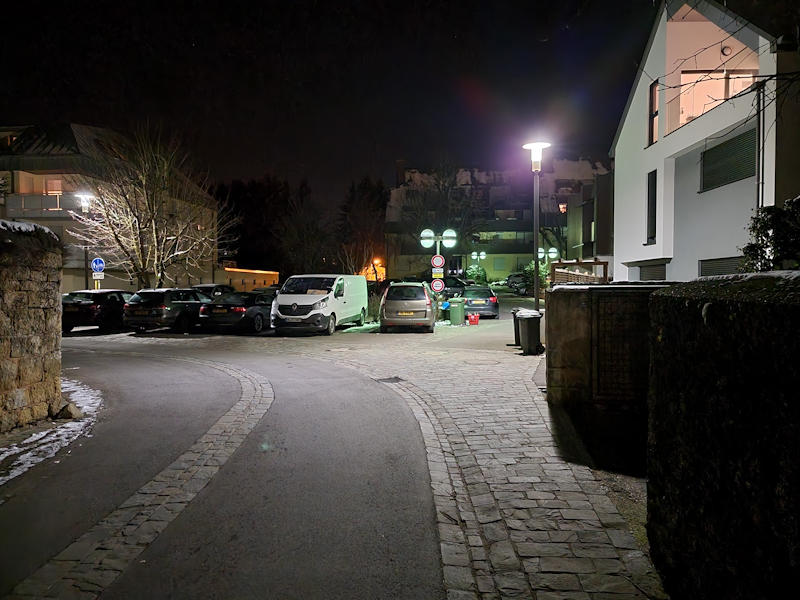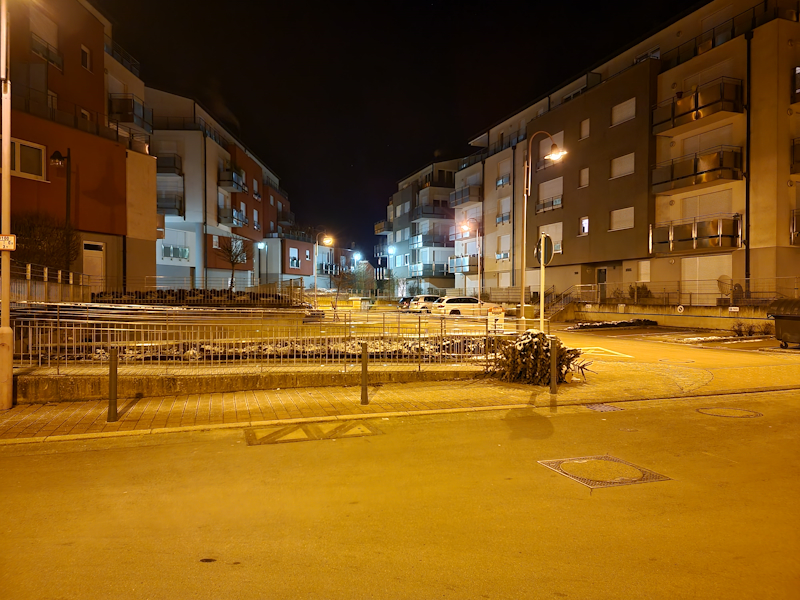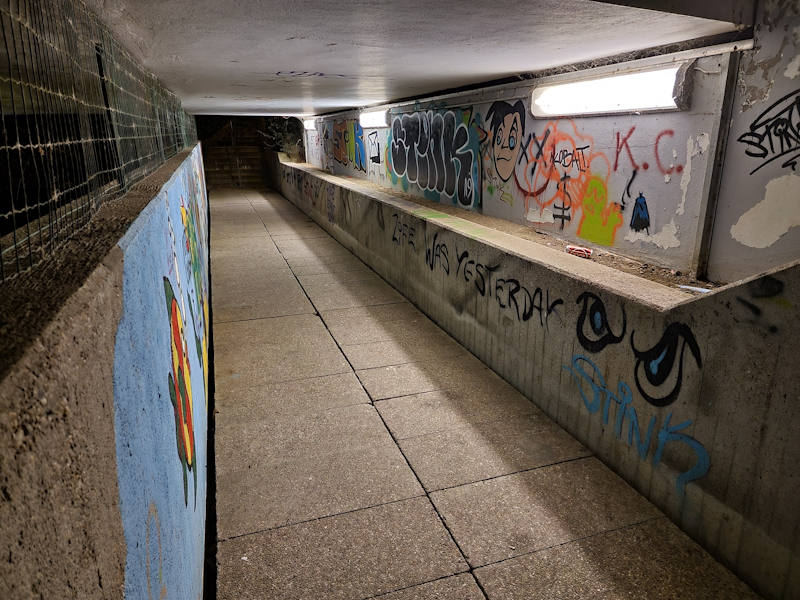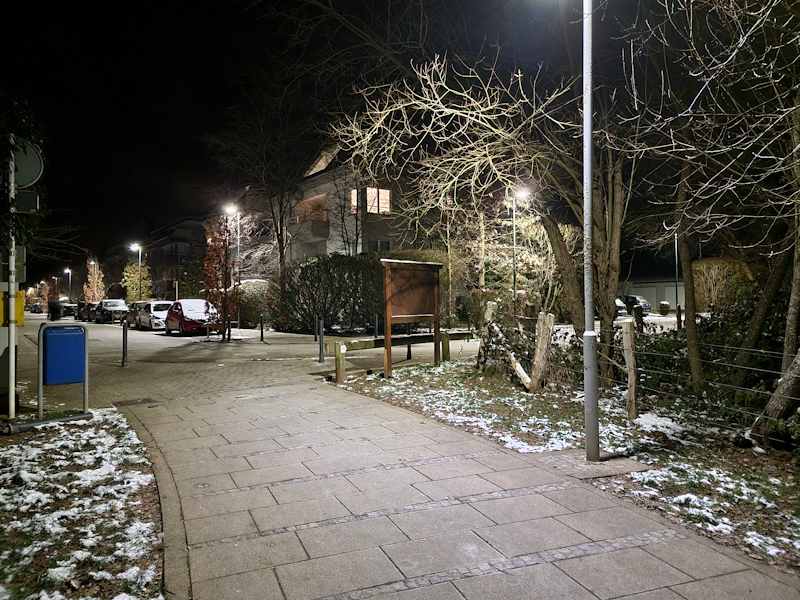The Samsung Galaxy S21 Ultra & S21 Review: The Near Perfect and The Different
by Andrei Frumusanu on February 22, 2021 12:00 PM EST- Posted in
- Smartphones
- Samsung
- Mobile
- Galaxy S21
- Galaxy S21 Ultra
Camera - Low Light Evaluation
Low-light photography of the new S21 series devices should be relatively uneventful. Both the Ultra and the regular models don’t have any superior light gathering abilities compared to their predecessors, so in general the differences between the generations should solely lie in terms of software algorithm updates – if there’s actually any.

[ S21U(S) - ] [ S21U(E) - ]
[ S21(E) - ] [ S20+(E) - ]
[ Note20U(S) - ] [ iPhone 12 Pro - ]
[ Mate40 Pro - ] [ Mi 11 - ]
[ Mi 10 Pro - ] [ Pixel 5 - ]
[ X-T30 ( ) ]
In the first scenario, we see the S21 phones showcase excellent results in their respective night modes. There are small differences when it comes to colour temperature and blacks, where the new Ultra phones don’t seem to be as fine-tuned as the Note20 Ultra or the baseline S21, but generally fall in amongst the best performing phones.

[ S21U(S) - ] [ S21U(E) - ]
[ S21(E) - ] [ S20+(E) - ]
[ Note20U(S) - ] [ iPhone 12 Pro - ]
[ Mate40 Pro - ] [ Mi 11 - ]
[ Mi 10 Pro - ] [ Pixel 5 - ]
[ X-T30 ( ) ]
This scene really wasn’t kind to the new Ultras, as the Note20 Ultra produced significantly better and more realistic shots in all capture modes. We’re again seeing some of Samsung’s stark software inconsistencies at play.

[ S21U(S) - ] [ S21U(E) - ]
[ S21(E) - ] [ S20+(E) - ]
[ Note20U(S) - ] [ iPhone 12 Pro - ]
[ Mate40 Pro - ] [ Mi 11 - ]
[ Mi 10 Pro - ] [ Pixel 5 - ]
[ X-T30 ( ) ]
The S21 Ultra issues continue here as well, the Snapdragon unit is just far blurrier than the Exynos and the Note20 Ultra, while the Exynos’ colour temperature is too cool and overcompensates the orange sodium lamps.

[ S21U(S) - ] [ S21U(E) - ]
[ S21(E) - ] [ S20+(E) - ]
[ Note20U(S) - ] [ iPhone 12 Pro - ]
[ Mate40 Pro - ] [ Mi 11 - ]
[ Mi 10 Pro - ] [ Pixel 5 - ]
[ X-T30 ( ) ]
In this scene I was curious to see the dynamic range the phones would be able to retain in night mode – those lamps actually weren’t all that bright at all, it’s just that the rest of the scene was just very dim.
The Samsung phones didn’t improve all that much generationally, and still lag behind the leader in low-light dynamic range, Huawei.

[ S21U(S) - ] [ S21U(E) - ]
[ S21(E) - ] [ S20+(E) - ]
[ Note20U(S) - ] [ iPhone 12 Pro - ]
[ Mate40 Pro - ] [ Pixel 5 - ]
[ X-T30 ( ) ]
This scene is easier to analyse, as essentially, we’re seeing little to no differences with the new S21 series phones bar a bit of colour temperature variations.

[ S21U(S) ] [ S21U(E) ]
[ S21(E) ] [ S20+(E) ]
[ Note20U(S) ] [ iPhone 12 Pro ]
[ Mate40 Pro - ] [ Mi 11 ]
[ Mi 10 Pro ] [ Pixel 5 ]
[ X-T30 ( ) ]
Going into lower light situations, we’re seeing larger differences. The S21 Ultra Snapdragon falls flat on its face here in terms of night mode processing as everything is a blurry mess. The Exynos variant fares significantly better, and is actually along with the Exynos S21 the best results of any phones night modes, going as far as clearly depicting the Orion and Pleiades constellations in the background sky.

[ S21U(S) ] [ S21U(E) ][ S21(E) ] [ S20+(E) ] [ Note20U(S) ]
[ iPhone 12 Pro ] [ Mate40 Pro - ] [ Mi 11 ] [ Mi 10 Pro ] [ Pixel 5 ]
[ X-T30 ( ) ]
Lastly, just for fun and because I had an unusually clear night sky, I tried out pointing the phones at the sky to see what happens. These are all handheld shots without a tripod. Sadly enough, the Ultra phones lagged behind the regular S20 and S21, and far behind the Huawei Mate 40 Pro.
Low-light verdict: Pretty much the same
Low-light photography on the S21 series, hasn’t really changed all that much from the S20 series. Frankly speaking, in some scenarios, it might be even worse due to the immature software, particularly on the Snapdragon S21 Ultra. We didn’t really expect any improvements this generation as essentially, it’s all pretty much the same hardware, but I was still disappointed to see that the software side of things is still handicapping Samsung from achieving better results.
The same conclusion applies here as on the daylight shots, in that we don’t really have a conclusion. The results are too inconsistent, and I’ve already had two newer firmware updates I would need to re-test things on. The picture quality will undoubtedly improve, but it’s getting quite tiring to wait months for Samsung to sort things out.










122 Comments
View All Comments
Andrei Frumusanu - Monday, February 22, 2021 - link
It's not, the software rendering part is extremely minor and has never had any significant impact on battery life.snowdrop - Monday, February 22, 2021 - link
So s21/s21+ > s21u for camera experience and s888 > e2100 for image quality. This strongly implies that the s21/s21+ with s888 would offer the best overall camera implementation of all the variants, but unfortunately this combination isn't featured in the article.Any hope of adding some shots from a s21/s21+ with s888 to the comparison?
Andrei Frumusanu - Monday, February 22, 2021 - link
The SD888 isn't definitive in having the better image quality.And no, I'm in Europe so getting Snapdragon Galaxies is hard, I have no plans to further attempt anything beyond the S21U.
snowdrop - Tuesday, February 23, 2021 - link
To me the s888 ultra shots all looked notably better (sharper, better shadow / mid / highlight detail, improved lens correction) with the occasional exception of better highlight detail when the e2100 chose a darker exposure and the one shot where the s21u s888 wasn't in focus. The grass / foliage processing on the e2100 is particularly terrible so it could just be that the scenes you chose exaggerated the e2100's weak spots.It looks like samsung used the stock qualcomm image processing stack for s888 models and is testing beta internal software on the e2100 ones.
I enjoy your excellent commentary on the computational photography capabilities of phone camera systems in your phone reviews. Have you considered including supplementary commentary from someone who has done dslr / lens reviews though to add a more photographer centric perspective though?
s.yu - Wednesday, February 24, 2021 - link
Uh pretty much from the first sample the Exynos was doing better, far better texture, though the SD caught up in a few subsequent samples, so this generation I say the processing is too close to call. Generally the SD variants had a better track record though.JoeDuarte - Monday, February 22, 2021 - link
Can anyone confirm whether the S21 with the Snapdragon has dual frequency GPS? Sorry if I missed it in the article. Dual frequency GPS is supposed to yield a huge accuracy boost, and maybe time to positioning too.JoeDuarte - Monday, February 22, 2021 - link
All the benchmark graphs are missing the S21, but Andrei is talking as though they include the S21. The graphs only show variations of the S21 Ultra, not the regular S21. Can we get the S21 results included?JoeDuarte - Monday, February 22, 2021 - link
Does Arm plan to succeed the A55 low power cores with a credible upgrade? Experts here have talked about this before, how the A55 is hopelessly outclassed by several generations of Apple low power counterparts at this point. Why have they iterated the A7x cores but not the A5x?Does anyone have insight into why Samsung's SoCs are so bad? It doesn't make sense for a company that owns the fabs, gets to develop the process nodes, and design the SoCs to be so far behind, spanning maybe a decade now. Is there no advantage, no synergies or co-optimization opportunities, in such complete vertical integration? It's supposed to be an advantage for Apple to design its own SoCs and cores. Why is it not an advantage for Samsung to do that and to*also* have the fabs and node development? Is there a talent issue? I wonder if maybe there just aren't enough engineers operating at the necessary level of skill to populate all these companies. The actual human cognitive science of how these teams do what they do is a black box, and apparently TSMC and Apple are able to do things that Samsung, Intel, and GF are not, and the difference is surprising.
nandnandnand - Thursday, February 25, 2021 - link
I think the Cortex-R82 points to further improvements to the efficiency cores being possible. Or Apple's own take on efficiency cores.Maybe we'll find out about an A55 successor within the next few months, before TSMC 3nm kicks off.
nandnandnand - Thursday, February 25, 2021 - link
Also, I think the "Helios" Neoverse E1 is better than A55, even discounting its SMT capability.